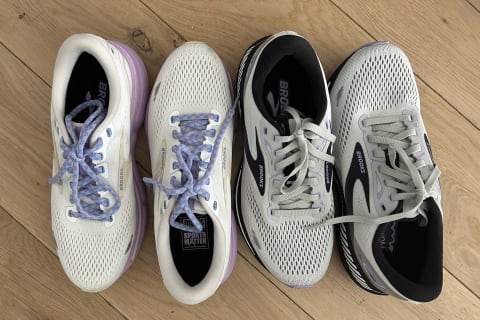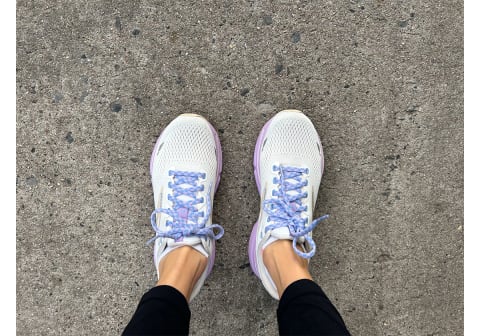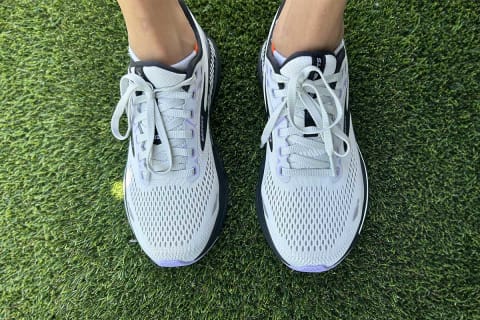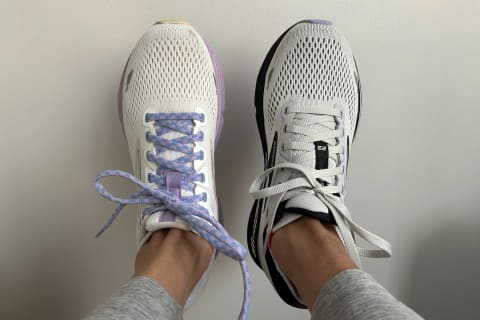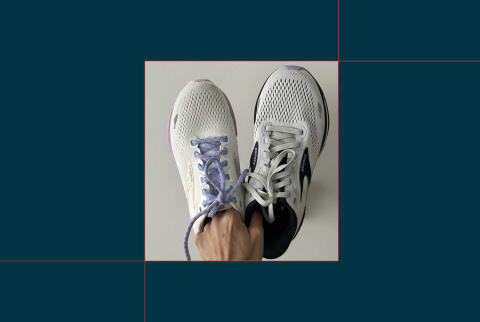
Image by Carleigh Ferrante / mbg creative
June 24, 2024
We carefully vet all products and services featured on mindbodygreen using our
Our selections are never influenced by the commissions earned from our links.
If you’ve ever asked a podiatrist or running coach for a sneaker recommendation, you’ve likely been steered toward Brooks a time or two. Personally, I’ve had countless experts recommend the Brooks Ghost running sneakers for my feet—but I have friends who swear by the Brooks Adrenaline.
To determine which Brooks running shoe is best, I tested the Ghost and Adrenaline extensively, poured through feedback from other runners, and spoke with three podiatrists.
Below, find my detailed comparison of the Brooks Ghost vs Brooks Adrenaline based on comfort, support, stability, cushioning, and responsiveness.
About the tester
- Name: Carleigh Ferrante
- Age: 35
- Foot type: Narrow, neutral arches, and bunions
- Activity level: Active
- Running experience: Four major world marathons and 10 half marathons
How I tested
I’ve been a distance runner for about 12 years, and I’ve run in both the Brooks Ghost and Brooks Adrenaline sporadically during that time. For the purpose of this review, I spent at least one week exclusively running in each shoe.
I’m not training for a race at the moment, so I typically run four to five days per week. When it comes to choosing the best running sneaker, I like to have one shoe that can do it all: sprints, long runs, interval training, treadmill runs, trail runs, etc.
- 3-mile outdoor run
- 8-mile outdoor run
- Interval training on a treadmill
- 100 to 400 meter sprints on a track
In addition to my own testing, I also gathered feedback from other runners with a variety of foot types who have worn Brooks sneakers for years.
I then used insights from three podiatrists to help determine which of these Brooks sneakers are best for each specific type of foot, stride, and running habits.
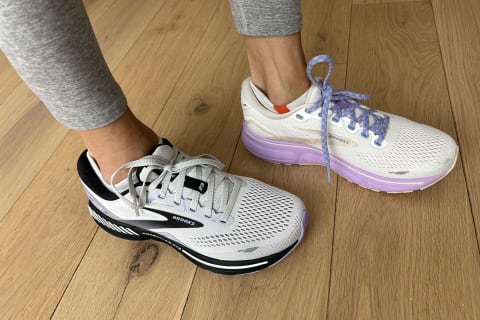
Image by Carleigh Ferrante / mbg creative
What is Brooks?
Brooks is a Seattle-based sportswear company making high-performance sneakers, clothing, and accessories. The brand’s designs are known for their cloud-like comfort, stability, and support available in a number of models.
Aside from the immense cushioning, one thing that stands out about Brooks is the GuideRails technology, which the brand uses in its designs to help stabilize the foot and improve alignment between the knee and ankle for reduced risk of injury.
A few designs have the APMA Seal of Acceptance (indicating that the shoes promote good foot health), and podiatrists have recommended the Brooks designs to mindbodygreen for running, walking, and everyday wear.
“Brooks focuses on biomechanics and offers shoes with excellent support and stability, particularly beneficial for those with overpronation or other gait issues,” says podiatrist Dina Gohil, DPM.
My experience testing the Brooks Ghost 16
-
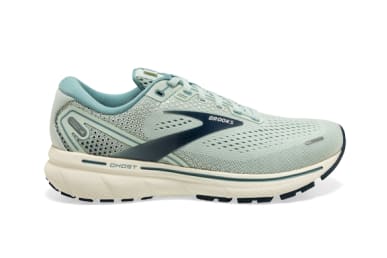
-
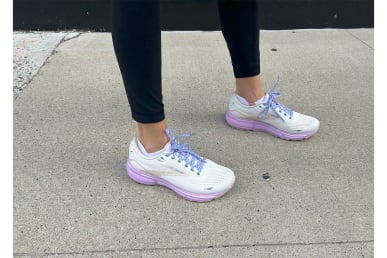
Image by Carleigh Ferrante / mbg creative
Brooks Ghost 16
Brooks Ghost 15
Sizes
5-13 (half, narrow, wide, & extra wide)
Pros & Cons
Cons
Cushioning in the forefront is a bit light
Like I said, I’ve been recommended the Brooks Ghost for years from running experts and podiatrists—and I had tried them sporadically prior to testing for this review. The Ghost is a neutral shoe with average stability and good support, making it a very popular option for a wide variety of runners.
Podiatrist Anne Sharkey, DPM, previously told me the Ghost are specifically great for those with high arches or wide feet. Another podiatrist, Hillary Brenner, DPM, touted the Ghost sneakers as one of her top-recommended shoes for runners seeking a neutral shoe.
The midsole is made of the brand’s DNA Loft v3, a Nitrogen-infused foam. Even on my longest run (10+ miles), these shoes are extremely comfortable.
I have a neutral gait, and—despite the thick, soft foam—my feet feel stable and supported in the Brooks Ghost. I also appreciate that the shoes are certified Carbon Neutral and made with 67.3% recycled materials in the upper.
My experience testing the Brooks Adrenaline 22
-
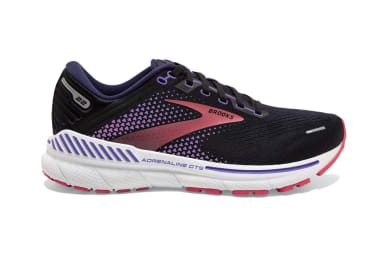
-
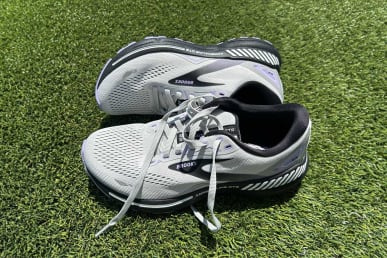
Image by Carleigh Ferrante / mbg creative
Brooks Adrenaline GTS 22
Brooks Adrenaline GTS 22
Pros & Cons
Pros
Exceptional stability and support
60% recycled materials in the upper
Great for all experience levels
Soft, comfortable cushioning
Cons
Some testers say they require a break-in period
On its 22nd iteration, the Brooks Adrenaline have been around for longer than the Ghost—and the Ghost were actually initially marketed as a “more neutral version of the Adrenaline.”
I dealt with a bout of knee pain years back, and it’s actually what led me to the Adrenaline. I wound up choosing a different brand long-term, but many of my runner friends with sensitive knees agree that the Adrenaline are a standout pick—and podiatrists love them too.
Sharkey previously recommended the Brooks Adrenaline for runners with knee pain and also for those with flat feet, noting that it hits the mark on comfort and shock absorption. At its core, the Adrenaline is a stability shoe; it’s designed to give guidance, stability, and support specifically for runners who overpronate (which, by the way, can lead to knee pain when you don’t have the right shoes).
I don’t experience knee pain anymore (and I don’t have flat feet)—but I still spent time testing the Brooks Adrenaline and was impressed by their comfort, support, and stability. The Guiderails technology really does keep your stride smooth over long or short distances.
Brooks Ghost vs Adrenaline
Brooks Ghost vs Adrenaline: Stability
Designed as a stability shoe above all else, the Adrenaline is the clear winner in this department. The Guiderails technology keeps your foot stable while you run and prevents excess movement or overpronation (the inward rolling of your foot).
This, plus added arch support, reduces strain on the muscles in your feet and legs—which is why the Adrenaline is such a standout pick for runners with flat feet or knee pain.
Brooks Ghost vs Adrenaline: Cushioning
I wouldn’t expect a shoe known for its stability to be so well-cushioned, but both the Ghost and the Adrenaline are some of the most cloud-like running shoes I’ve tested. The cushioning feels extremely soft, yet still supportive.
Both shoes have a 12mm drop—and when compared to the shoes I typically run in (ASICS Gel Nimbus or the Puma Deviate Nitro), the Ghost and the Adrenaline are more plush. However, a brand like Hoka will likely feel even softer.
There are mixed reviews on which shoe is softer, but I personally find the Adrenaline to be slightly more cushioned.
Brooks Ghost vs Adrenaline: Responsiveness
While neither option is necessarily designed for speed training, they’re both fairly responsive. In testing, I was able to ramp up my speed faster in the Ghost than in the Adrenaline, perhaps because they’re just a tiny bit lighter.
At the end of the day, I’d recommend the Ghost and the Adrenaline as an all-around training sneaker (my favorite type of running shoe!). I was able to run a range of distances in both without any discomfort, and my feet felt supported.
If you’re looking for an extremely responsive shoe for sprinting, you’ll be better off with something more lightweight and performance-based, such as the Saucony Endorphin Speed.
Brooks Ghost vs Adrenaline: Sustainability
The footwear industry is responsible for a lot of overproduction, and traditional brands do not use the most eco-friendly materials. We always pay close attention to brands who are making strides toward a more sustainable production process and better materials—and Brooks is making an effort.
The Ghost sneaker wins this category, as a carbon-neutral shoe with 67% recycled materials in its upper. The Adrenaline uses 60% recycled materials in the upper, so it’s still a more eco-friendly choice than many competitors.
Which should you choose?
Given each shoe’s strong suits, there’s a clear consensus for which shoe is best—and it all depends on your gait and foot type.
Choose the Brooks Ghost if you have a neutral or high arch and do not need extra stability. It’s also a great choice if you do like to mix in some speed training, due to slightly better responsiveness.
Chose the Brooks Adrenaline if you have flat feet and/or tend to overpronate and need a bit more support to keep your stride stable.
The Ghost and Adrenaline sneakers are both extremely comfortable and great for all running experience levels. You can wear either on a variety of surfaces (road, track, or treadmill), the cost is exactly the same ($140), and the materials are high-quality and durable.
The takeaway
After spending weeks testing the Brooks Ghost and Brooks Adrenaline, I can see why so many podiatrists and running experts recommend these sneakers for all types of runners.
When comparing the Brooks Ghost vs Adrenaline, both shoes are extremely comfortable with thick cushioning—but the Adrenaline offers more stability and the Ghost is a bit more responsive.

